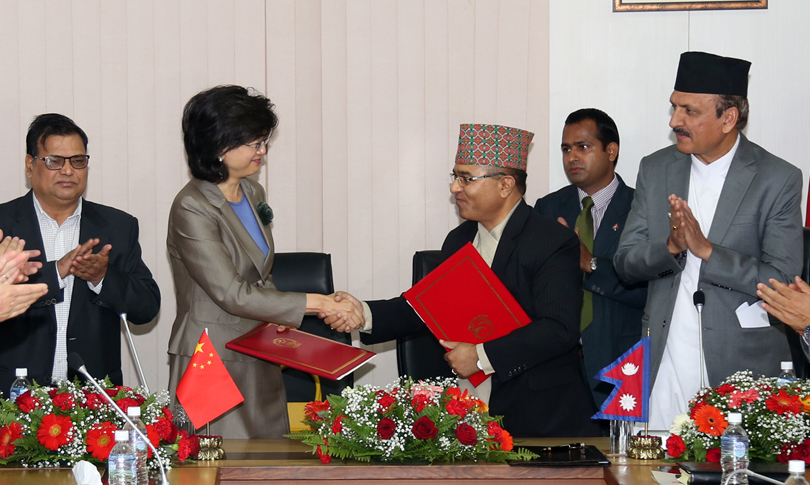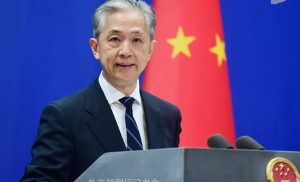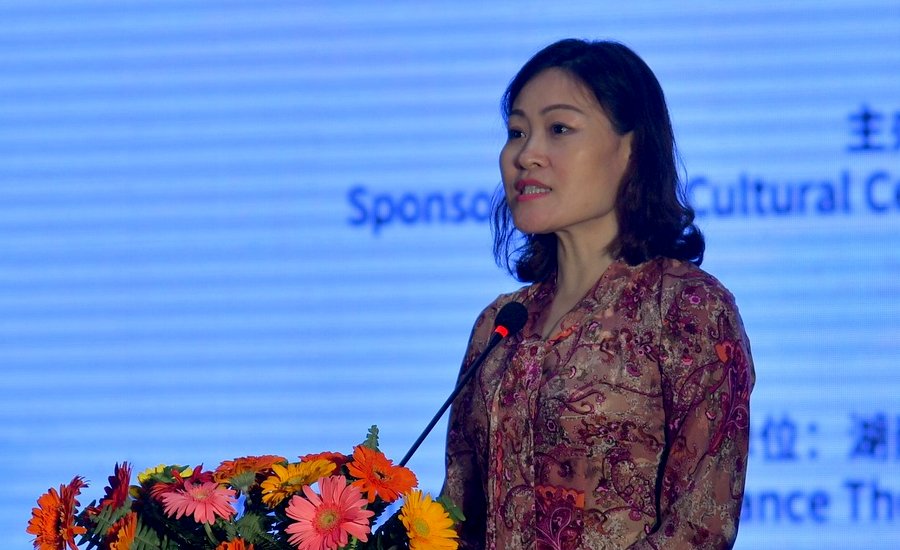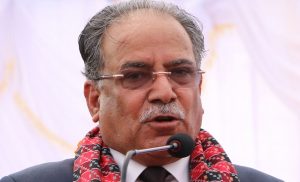
A decade has passed since Nepal first showed support for China’s ambitious Belt and Road Initiative (BRI). It has been more than six years since Nepal signed its framework agreement. However, there is a rising sense of uncertainty surrounding the actual implementation of the initiative.
There has been no progress from China when it comes to BRI projects. But, China’s claim of including projects that were initiated before the Belt and Road Initiative (BRI) has heightened the existing ambivalence and scepticism. This has further amplified doubts and uncertainties about the actual implementation and outcomes of the initiative in Nepal.
Nepal supported the concept put forward by Chinese President Xi Jinping in the name of One Belt One Road (OBOR) in 2013. The project was later named the Belt and Road Initiative.
On May 12, 2017, Nepal formally signed the Belt and Road Initiative framework agreement. The Memorandum of Understanding (MoU) was signed by then-Foreign Secretary Shanker Das Bairagi and the then-Chinese Ambassador Yu Hong. The signing ceremony was attended by then Deputy Prime Minister Krishna Bahadur Mahara and then Foreign Minister Prakash Sharan Mahat.
Following the signing of the framework agreement, Nepal sent a high-level delegation led by the then Foreign Minister Mahara to participate in the first OBOR (One Belt, One Road) conference held in China on May 14 and 15, 2017.
Following the conference, China requested Nepal to provide a list of projects that could be implemented under the BRI. However, Nepal has faced challenges in presenting a comprehensive list of projects with detailed blueprints to fulfil this request.
Former President, Bidya Devi Bhandari, in April 2019, went to Beijing to participate in the second BRI conference. After President Bhandari participated in the BRI conference, both Nepal and China expressed enthusiasm about its implementation.
Despite no tangible progress on the ground, the participation agreement in the Belt and Road Initiative has been renewed twice. The first renewal took place in 2020, three years after the initial signing, and the second renewal occurred last year.
However, there is still a lack of firm consensus regarding whether to proceed with specific projects under the initiative. The decision-making process regarding project selection and implementation has encountered difficulties in reaching a solid consensus.
According to Dhaniram Sharma, the spokesperson for the Finance Ministry, there has been no agreement reached on any project associated with the Belt and Road Initiative in Nepal, and thus, no implementation has taken place.
“Until now, no agreement has been reached on any project. We have not taken any quotation either”, Sharma told Onlinekhabar.
Nepal initially sent a list of 35 projects to the Belt and Road Initiative. Former Foreign Minister Pradeep Kumar Gyawali says after President Bhandari returned from participating in the second BRI conference, Nepal sent a list of those projects to China.
Later, at the request of the Chinese, Nepal reduced the number of projects to only nine and sent a list. He said after the list of those projects was sent to China and there was no response.
“Nepal selected nine projects under BRI and sent them to China and discussed their investment,” Gyawali told Onlinekhabar, “I don’t know what happened after that.”
To date, the government of Nepal has not provided any specific information regarding the progress made in the Belt and Road Initiative. Even officials from the Ministry of Foreign Affairs and the Ministry of Finance have refrained from making formal statements on this matter.
But high-level Chinese diplomats are claiming that the projects being worked on under Chinese investment and contracts are part of the Belt and Road Initiative.
BRI claim on the full project

Chinese diplomats have consistently emphasised a connection between ongoing construction projects in Nepal and the Belt and Road Initiative. However, Nepal has refrained from either acknowledging or criticising the progress of the initiative, leading to a noticeable disparity in their respective stances.
The lack of accountability or official response from Nepal has raised questions and underscored the importance of transparent communication to address these concerns and provide accurate information regarding the state of BRI projects in the country.
According to former Finance Minister, Prakash Chandra Lohani, the government should clarify the progress being made in the Belt and Road Initiative, otherwise, it will create a negative impact on the diplomatic relationship between Nepal and China.
“It is the government’s responsibility to clarify the progress made. The government should be serious about the way how China is interpreting old projects as part of the initiative,” says Lohani. “Our government should clarify the agreement and should explain what has been done and not done according to the agreement, in a diplomatic way.”
Recently, China’s ambassador to Nepal, Chen Song said that Pokhara International Airport is an ambitious project of China under the Belt and Road Initiative. This is the third time the Chinese side has made this claim. Previously, the then Acting Ambassador Wang Xin had also made the same claim while addressing the opening ceremony of the airport last December.
In May of the previous year, the then-Chinese Ambassador Hou Yanqi also claimed this for the first time in a press conference. She said apart from the Pokhara airport, projects such as Lumbini and Tribhuvan airports are also considered part of the Belt and Road Initiative.
“All the main projects built by China in Nepal are within the framework of BRI,” she said in a virtual press conference. “First, the Gautam Buddha Airport in Lumbini. The second is Pokhara Airport. Third, Tribhuvan International Airport.”
According to Lohani, even though Asian Development Bank (ADB) has invested in Lumbini Airport, China claims it as a BRI project because Chinese contractors have worked on it.
In the case of the Pokhara Airport, the funding for its construction includes commercial loans and grants from various sources, not exclusively from China. However, the construction company involved in the project was Chinese, which led China to claim it as a project under the Belt and Road Initiative.
Likewise, while the cost of upgrading the Tribhuvan International Airport was covered by the Nepali government, the responsibility for the project was entrusted to a Chinese company. As a result, it has been considered a part of the initiative as well.
Not only are the projects being built with Chinese grants or loans, but Hou Yanqi said that the projects contracted by Chinese companies are also being built under the BRI.
According to former foreign minister Gyawali, it is wrong for powerful countries to misinterpret old projects as projects under strategic projects such as BRI.
Chandra Ghimire, the former commerce secretary of the Nepal government, says that the government should be serious about this matter.
“The MCC issue was later linked to the Indo-Pacific, so if China says that the old projects were built under its strategic projects, it will cause geo-political and economic problems. So the government needs to be serious about this,” says Ghimire.
China’s claims contradict the concept of BRI

So far, China does not seem to be interested to talk about BRI in formal forums or meetings with Nepal. Following the dissolution of the parliament by KP Sharma Oli, Nepal has witnessed a surge in geopolitical interest, including increased engagement from China.
Chinese Senior Diplomat and then Foreign Minister Wang Yi and speaker of the Chinese Congress Li Zhanshu also came to Nepal. However, none of them openly discussed the BRI. Instead, China has expressed its interest in bridging the widening gap and strengthening ties with Nepal.
Lately, official and unofficial visits have also been made to Beijing from Nepal. Recently, former foreign minister Narayan Khadka visited China. Apart from that, Ganesh Timilsina, who is currently a chair of the National Assembly, has returned to Nepal after visiting China. There has not been any official statement released regarding the discussion and progress made on BRI during these visits.
In terms of party, leaders of the Maoist Center and UML have visited China several times. Discussions during those visits cannot be considered formal.
But Chinese diplomats are claiming that the old project is under BRI, ignoring the issues mentioned in the concept put forward by their own president.
According to the concept of BRI, China has mentioned that projects will be selected through its five pillars and three stages.
Those areas are:
- Policy combination
- Road/transportation network
- Business
- Economic coordination
- Public relations
As per the concept of the Belt and Road Initiative, the project selection process involves two governments in the initial phase.
In the second stage, Chinese government-controlled companies undertake a study of the project’s commercial feasibility.
Subsequently, in the third stage, Chinese government banks provide loans for the approved projects. Only after these steps are completed, the strategic project is initiated in accordance with the BRI concept.
To date, even the first phase of the Belt and Road Initiative implementation, which involves the selection of projects by two governments, has not been completed. As Nepal and China have not yet chosen any specific projects under the BRI, the progress in terms of project implementation appears to be stalled.


























